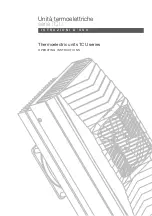
33
8. RA-4/4A Power Supply Troubleshooting
G BOARD
FROM Q6011/C
VCC SW.
FROM IC6005/4
REGULATION
FROM
IC6011/3
VCC SW.
D6010
R6020
LOW B+ PROTECT
FROM D6002.3
SWITCHING B+
R6008
R6007
D6004
MTZJ - 12B
R6011
Q6002
N
R6015
R6016
Q6005
SOFT
START
R6023
D6014
Q6006
D6023
Q6003
N
C6027
P
R6028
D6024
R6033
C6028
R6032
D6033
R6034
R6029
R6031
SQUARE WAVE
TO IC6002/12
IC6004/10
SQUARE WAVE
TO IC6002/10
IC6004/12
FROM Q6004
INRUSH
CURRENT
LIMITER RELAY
PROTECT
RT
C1 VCC C2
E2
GND
C
DTC
E
AMP1
DPC
REF OUT+
E
AMP2-
E AMP-
E1
C6016
2 2uF
P
8
12
11
10
9
2
15
14
13
1
4
5
7
6
IC6003
OSCILLATOR
IR3M02
FIGURE 8-4 - OSCILLATOR & SOFT START
8.5TVP14
6/26/02
Regulation is provided by varying the operating frequency based on the error amp input at IC6003/pin 1. Initial
soft start is provided by keeping Q6006 on for about three seconds at turn on due to C6016 charging. This will
pull down the regulation error loop and cause the IC to run at high frequency while the secondary voltages are
charging their filter capacitors. The only purpose of Q6005 is to discharge C6016 when the unit is turned off.
Should the unregulated B+ drop approximately 20%, Q6002 will turn off when zener D6004 releases, allowing
Q6003 to turn on and lock the oscillator into soft start. This is done to protect the switching transistors from
overheating since they will now have to maintain secondary voltages at a lower frequency. Higher current will be
needed and they will eventually fail.
Referring to Figure 8-5, IC 6002 and 6004 receive the square waves from IC6003 and utilize them to drive the
switching transistors Q6007, Q6008, Q6009 and Q6010. These transistors work in pairs to send current in both
directions through the primaries of T6001 and T6002. As an example: When pin 7 of IC6002 goes high, pin 1 of
IC6004 will also be high. Current will now flow from Q6008 through C6022 into the primary of T6002 and follow
a parallel path to C6023 into T601 primary. The ground return path will be provided by Q6009. The process
reverses with Q6010 and Q6007 working together to reverse current.
The RA-4 chassis is protected using several circuits for over-voltage and over-current conditions and these will
be covered later in Chapter 9. The following troubleshooting procedures will assume that no protection event
has occurred causing the timer LED to blink in diagnostic sequences, and the set is not completely dead as
described in the previous section on the standby supply.
NOTE: One item to remember is that the FET transistors used in this circuit are very rugged and if they have
shorted, the possibility is high that transients entered the AC line or there may be a high current short, particularly
in the 135V line.
















































